Uhlan
Uhlans (/ˈuːlɑːn, ˈjuːlən/; Polish: Ułan; German: Ulan ; Lithuanian: Ulonas) were Polish-Lithuanian light cavalry units armed with lances, sabres and pistols. The Polish uhlans became the model for many general-purpose cavalry units throughout Europe in the early 19th century as use of traditional heavy cavalry declined. The title was later used by lancer regiments in French, Russian, Prussian, Saxon, Austrian and other armies.[lower-alpha 1]
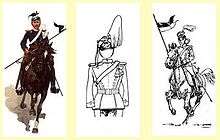
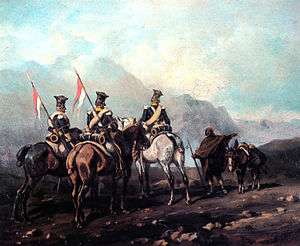
Uhlans typically wore a double-breasted jacket (kurtka) with a coloured panel (plastron) at the front, a coloured sash, and a square-topped Polish lancer cap (rogatywka, also called czapka). This cap or cavalry helmet was derived from a traditional design of Polish cap, made more formal and stylised for military use. Their lances usually had small, swallow-tailed flags (known as the lance pennon) just below the spearhead.
History
Origins
In the Turkic Tatar language (written oglan or ulan), "uhlan" means, amongst other things, a brave warrior or young man. It can also be referred to "Ulan zalata" ("Red-buttoned ones" in the Kalmyk/Oirat language) – another generally accepted name for the Kalmyk/Oirat people, who played a significant military role on the steppes on both sides of the lower Volga river basin from the middle of the 17th century until their return to their Eastern Dzhungar Khanate in 1771. The Kalmyk/Oirat/Dzhungar cavalry made wide spread use of lances both in European as well as Central Asian wars. During the Polish-Lithuanian Union, the name "Ułan" was the surname (family name) of a Lithuanian Tatar noble family from Jašiūnai, whose male family members, like many Lithuanian nobles, had regularly served as light cavalrymen for the Lithuanian grand dukes and later Polish kings since at least the 15th century. One of the family members, Colonel Aleksander Ułan, was the commander of a Polish light cavalry regiment in the service of Polish-Saxon kings, Augustus II the Strong and Augustus III. After Ułan's death his regiment was nicknamed Ułanowe dzieci (Ułan's children) and Ułanowe wojsko (Ulan's army) and then shortened to Ułans. Prior to 1764, all Polish-Lithuanian Tatar cavalry regiments in Saxon service were named Ułani (Uhlans or Ulanen).
Once the Golden Horde Tatar (sometimes also spelled "Tartar") families had settled in Lithuania in the late 14th century, they were required to perform military service for the Grand Duke of Lithuania and later the Polish King. The Poles started incorporating much of their military vocabulary and many of their traditions, along with their strategy and tactics. Lithuanian Tatars, mostly Muslim, served as part of the Royal armies during various battles of the late Middle Ages. Their tasks were to conduct reconnaissance in advance of the heavier cavalry banners (knights). With the end of armored knights during the 16th century, the Lithuanian Tatars were organized in light (Tatar) banners – armed with light lance, bow, saber and sometimes war axe, serving as companions (towarzysz) and retainers (pocztowy) – while equally lightly armed hussars were converted into heavy companies of winged hussars. Tatar companions serving within their own Tatar companies (banners) lasted until the 1770s, when major cavalry reforms were carried out within the Polish-Lithuanian army and were included in the reformed cavalry regiments. The last Polish King, Stanisław August Poniatowski, had a Uhlan guard regiment simply known as the Royal Uhlans. It was disbanded in 1794 or 1795.
18th century
The first Uhlan regiments were created in the early 18th century, during the 1720s, in the Polish–Lithuanian Commonwealth.
As developments in battlefield tactics and firearms had combined with the increasing sizes of early modern armies to make heavy armour obsolescent (though retained by the cuirassier regiments), lighter units became the core of the cavalry, distinguished only by the sizes of their men and mounts and by the tasks that they performed (i.e., reconnaissance, skirmishing, or direct charges).
During the period preceding the Partitions of Poland, Uhlan formations consisting of Poles or Lithuanian Tatars were created in most surrounding states simply because the Polish Crown did not have the resources or political will to maintain a numerous army. Speed and mobility were the key to the effectiveness of light cavalry armed with lances.
The Uhlan regiment formed by the Kingdom of Prussia in 1740, the so-called Natzmer-uhlans, was used ineptly, employing heavy-cavalry tactics against fortified positions. The regiment failed to distinguish itself favorably in the first of the Silesian Wars and was disbanded shortly afterwards.
In 1745, Saxony, engaged in a personal union with the Polish-Lithuanian Commonwealth, created a Polish Uhlan regiment called "Saxon Volunteers". Shortly after, the Marechal de Saxe created a Polish Ulan regiment for the French king, Louis XV.
King Stanisław August Poniatowski of Poland formed a regiment of royal guards equipped with lances, szablas, and pistols, each guardsman uniformed in kurta and czapka. This unit became the prototype for many other units of the Polish cavalry, who started to arm themselves with equipment modelled after Uhlan regiments and mediaeval Tatars.
In the Polish-Lithuanian Commonwealth the Uhlans inherited the status and traditions of the winged Polish hussars in 1776, thus becoming National cavalry. The Austrian empire also formed a "Uhlan Regiment" in 1784, composed primarily of Poles. Uhlan regiments recruited from Austrian cavalrymen were raised in 1791.
19th century
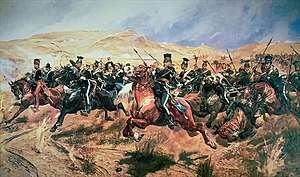
After the start of the Napoleonic Wars, uhlan formations were raised by the Duchy of Warsaw. Polish lancers serving with the French Army included the Vistula Legion and the Chevaux-légers lanciers de la Garde Impériale. The lancers of the Polish expeditionary corps, which fought alongside the French in Spain and Germany, spread the popularity of the Polish model of light cavalry. After the Battle of Somosierra, Napoleon said that one Polish cavalryman was worth 10 French soldiers. The chevaux-légers, French light cavalry units from the 16th century till 1815, were remodelled after the Uhlans. Following the Treaty of Tilsit in 1807 lancer regiments designated as Uhlans were reintroduced in the Prussian service.
During and after the Napoleonic Wars, cavalry regiments armed with lances were formed in many states throughout Europe, including the armies of Italy, Spain, Portugal, Sweden and Russia. While cavalry carrying this weapon were usually specifically designated as lancers or uhlans, in some instances the front rank troopers of hussar or dragoon regiments were also armed with lances.[1]
In one notable action during the Waterloo Campaign as the French lancers advanced out of a defile — created by the bridge over the Dyle and village of Genappe — although they were stationary as they formed up, they lowered their lances to receive a charge by the sabre wielding British 7th Hussars (light cavalry) who were then unable to press home their charge. However once the lancers advanced in slight disorder (up the valley slope of the Dyle), they were overridden by the British 1st Life Guards (heavy cavalry armed with sabres) who drove them back through Genappe and onto the bridge.[2]
During the Battle of Albuera, the 1st Vistulan Lancers Regiment in French service virtually annihilated three of four of the British infantry regiments comprising Colborne's 1st Brigade. In 1816 the British army established its own lancer regiments; converting four regiments of light dragoons for the purpose[3] and adopting items of Polish equipment and uniforms, including the square-topped Polish uhlan cap.
The traditions of the Polish uhlans were preserved during the Kingdom of Poland. They fought both in the November Uprising of 1830 and in the January Uprising of 1863.
Uhlans were deployed in the Franco-Prussian War by the Prussian Army in a variety of traditional light cavalry roles. During the siege of Paris, uhlans were tasked with shadowing passenger balloons launched from the city: their capacity for rapid movement made uhlans the only troops able to keep pace with the balloons, either to seize them on landing or at least report trajectory and destination.[4]
World War I
German Uhlans
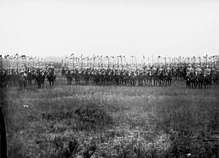
In 1914, the Imperial German Army included 26 Uhlan regiments, three of which were Guard regiments, 21 line (16 Prussian, two Württemberg and three Saxon) and two from the autonomous Royal Bavarian Army. All German Uhlan regiments wore Polish style czapkas and tunics with plastron fronts, both in coloured parade uniforms and the field grey service dress introduced in 1910. Because German hussar, dragoon and cuirassier regiments also carried lances in 1914, there was a tendency among their French and British opponents to describe all German cavalry as "uhlans".
The lance carried by the uhlans (and after 1889 the entire German cavalry branch) consisted of a 318 cm (ten-foot and five-inch) long tube made of rolled steel-plate, weighing 1.6 kg (three pound and nine ounces). The lance carried below its head a small pennant in differing colours according to the province or state from which the regiment was recruited. The four edged spear-like point of the shaft was 30 cm (12 inches) long and made of tempered steel. The butt end of the shaft was also pointed so that (in theory) the lance could be wielded as a double ended weapon.
After seeing mounted action during the early weeks of World War I, the Uhlan regiments were either dismounted to serve as "cavalry rifles" in the trenches of the Western Front, or transferred to the Eastern Front where more primitive conditions made it possible for horse cavalry to still play a useful role. All 26 German Uhlan regiments were disbanded in 1918–1919.
Austrian Uhlans

There were 11 regiments of uhlans (spelt "Ulan") in the Austro-Hungarian cavalry, largely recruited in the Polish speaking parts of the Empire. They wore czapkas in regimental colours but otherwise were, after 1867,[5] dressed in the light blue tunics and red breeches of the Austro-Hungarian dragoons, without Polish features. Their lances were similar in design to those of the German cavalry but had wooden shafts (of ash). In 1884 the lance was replaced by the sabre in the Austro-Hungarian cavalry, although the Ulan regiments retained their traditional titles and lancer caps until World War I.[6]
As with other armies, the Austro-Hungarian Uhlans were forced into a largely dismounted role by the realities of trench warfare by the end of 1914. The blue and red peacetime uniforms were replaced by field grey during 1915. There was however one last opportunity for traditional glory when on 21 August 1914 the uhlans and dragoons of the 4.Kavalleriedivision clashed with their counterparts of the Imperial Russian 10th Cavalry Division in classic cavalry style at the Battle of Jaroslavice.
Polish Uhlans
Józef Piłsudski's Polish Legions (an independent formation serving with the Austro-Hungarian Army) had a small Uhlan detachment. Commanded by Władysław Belina-Prażmowski, they were modelled after the Uhlans of the Napoleonic period. This unit was the first element of the Central Powers to enter Polish lands during World War I. After Poland's independence in 1918, Uhlan formations were raised in all parts of the country. They fought with distinction in the Greater Poland Uprising, the Polish-Ukrainian War and the Polish-Bolshevik War. Although equipped with modern horse-drawn artillery and trained in infantry tactics, the Uhlan formations kept their sabres, their lances and their ability to charge the enemy. Among other battles, the Uhlan units took part in the Battle of Komarów of 1920 against the invading Soviet Konarmia, the last pure cavalry battle in history.
Russian Uhlans
The Imperial Russian Army had converted its 17 line Uhlan regiments to dragoons in 1881 as part of a general modernization of the Russian cavalry. During this period only the two Uhlan regiments of the Russian Imperial Guard retained their special distinctions. In 1910, however, the historic line regiments of Uhlans had their lances, traditional titles and distinctive ceremonial uniforms returned to them. From 1910 to 1918 the designation of "Uhlan" had however become simply a historic distinction in the Russian cavalry (many of whom carried lances), without tactical significance.[7]
Interwar
In the period between the world wars, the Polish cavalry was reformed, with some units retaining their Uhlan traditions. However, in contrast with its traditional role, the cavalry was no longer seen as a unit capable of breaking through enemy lines. Instead it was used as a mobile reserve and employed infantry tactics: the soldiers dismounted before the battle and fought as infantry (dragoon), yet retained the high mobility of cavalry. Technically speaking, in 1939 Poland had 11 brigades of mounted infantry and no units of cavalry as such.
As noted above, the uhlans of the Imperial German Army were disbanded at the end of World War I. However, lances continued to be carried by certain cavalry regiments of the new German Army (Reichsheer) permitted by the Treaty of Versailles. As late as 1925, Major General von Seeckt, Commander of the Reichsheer, rejected a General Staff proposal that lances be abandoned as unsuited for a modern army.
World War II
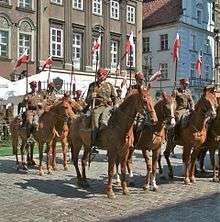
Although the Polish cavalrymen retained their sabres, after 1934 the lance was no longer standard issue, but was retained only for training purposes and for flying squadron pennants.[8] Instead, the cavalry units were equipped with 75mm field guns, light tanks, 37mm anti-tank guns, 40mm anti-aircraft guns, as well as anti-tank rifles and other modern weapons. Although there were cavalry charges during World War II, very few were successful.
A popular myth is that Polish cavalry armed with lances charged (and were annihilated by) German tanks during the September 1939 campaign. This arose from the misreporting (both intentional and unintentional) of the Charge at Krojanty on 1 September, when two squadrons of the Polish 18th Lancers armed with sabres scattered German infantry before being caught in the open by German armoured cars.[9]
When the remnants of the Polish cavalry forces was reconstituted in exile in 1943 as the 1st Armoured Division the 24th Uhlans (24 Pułk Ułanów) were equipped as an armoured regiment with Sherman tanks. The regiment disbanded in 1947.
Modern
Present-day military units with the title or historic role of "uhlans" include:
- Kazakhstan: "Жас Ұлан" (zhas ulan) regiments exist in the modern Kazakhstan Army[10] though not as mounted cavalry.
- Poland: Presidential Mounted Cavalry Squadron of Polish Armed Forces (Polish: Szwadron Kawalerii Wojska Polskiego)[11]
- Lithuania: Grand Duchess Birutė Uhlan Battalion (Lithuanian: Didžiosios kunigaikštienės Birutės ulonų batalionas)[12] this unit has the historic title, but not the cavalry role. It is a combat battalion.
Appearances in popular culture
- Uhlans are mentioned in Arthur Conan Doyle's short story "The Lord of Chateau Noir".
- In Leo Tolstoy's seminal work "War and Peace", Uhlans appear several times from the start of Book III.
- In Joseph Roth's 1932 novel The Radeztky March, the protagonist is an officer of the Austro-Hungarian Uhlans.
- Anton Hofmiller, the narrator of Stefan Zweig's Beware of Pity is an officer in an Uhlan regiment in 1913 Austro-Hungary.
- "Black Uhlan of the Rhine" – nickname of heavyweight champion Max Schmeling.
- Valparaiso University's sports teams were nicknamed "Uhlans" until World War II, then changed to "Crusaders".
- Age of Empires 3: The German Civilization Uhlans are the primary cavalry a player can build.
- In Gunther Grass's 1959 novel The Tin Drum, the protagonist Oskar Matzerath frequently refers to the Polish Uhlans as well as their misreported charge on 1 September 1939.
- In Italo Calvino's 1979 novel If on a Winter's Night a Traveller, Gritzvi (Outside the town of Malbork) prizes his Uhlan helmet and is reluctant to leave it in Ponko's care.
- Many light to medium Battlemech and combined arms regiments in the Battletech/MechWarrior universe use the descriptive "Uhlans" in their unit names (e.g., the 1st Kathil Uhlans).
- In Star Trek the Romulan equivalent of an Ensign is an Uhlan.
- The 19th century German pulp-fiction novel Die Liebe des Ulanen (″The Uhlan's Love″) by Karl May has, like everything else by this author, acquired cult status in German-speaking countries and, although several thousand pages long, is still in print.
- In Graham Greene's 1958 novel Our Man in Havana, Dr. Hasselbacher is an ex-Uhlan officer.
- Battle Picture Weekly's popular feature "Charley's War", by Pat Mills & Joe Colquhoun, had Uhlans playing a major role in episodes 252 & 253.
- The Black Uhlans is the name of one of Australia's Outlaw Motorcycle Clubs that has been active since 1970.
Notes
- "At its reorganization in 1717, the Polish-Lithuanian army contained both heavy and light cavalry ... The light cavalry was also composed of Polish noblemen, but the Tartars, whom a grand duke of Lithuania had received into his states during the conquests of Tamerlane, were admitted on an equal footing, both as officers and privates. They wore no defensive armour, but in other respects were equipped like the heavy cavalry, only in a less costly manner. One of their first leaders was a Lithuanian nobleman named Huland, whence the term hulan or uhlan [comes]" (Roemer 1863, p. 345).
- Rawkins 1977, p. 27.
- Siborne 1848, pp. 276–281.
- Barthorp, Michael. British Cavalry Uniforms Since 1660. p. 88. ISBN 0-7137-10438.
- Horne 2007, pp. 129-130.
- Knötel, Knötel & Sieg 1980, pp. 30-31.
- Lucas, James. Fighting Troops of the Austro-Hungarian Army 1868-1914. p. 112. ISBN 0-946771-04-9.
- Cornish & Karachtchouk 2001, p. 13.
- Zaloga 1983, p. 5 & 32.
- Zaloga 1983, p. 8.
- "Archived copy". Archived from the original on 22 July 2011. Retrieved 24 August 2010.CS1 maint: archived copy as title (link)
- http://www.brepr.wp.mil.pl/en/49.html Archived 18 May 2015 at the Wayback Machine
- https://kariuomene.kam.lt/lt/kariuomenes_struktura/kontaktai_1614/382.html
References
- Cornish, Nik; Karachtchouk, Andrei (2001), The Russian Army 1914-18, Oxford: Osprey Pub, p. 13, ISBN 1-84176-303-9
- Horne, Alistair (2007), The Fall of Paris, Penguin Books, pp. 129–130
- Knötel, Richard; Knötel, Herbert; Sieg, Herbert (1980), Uniforms of the World, New York: Scribner', pp. 30–31, ISBN 0-684-16304-7
- Rawkins, W.J. (1977), The Russian Army 1805 – 14, Anschluss Publishing
- Roemer, Jean (1863), Cavalry; its history, management, and uses in war ... With illustrations, p. 345
- Siborne, William (1848), The Waterloo Campaign, 1815 (4th ed.), Westminster: A. Constable
- Zaloga, S. J. (1983), The Polish Army 1939-45, London: Osprey, ISBN 0-85045-417-4
Further reading
| Wikisource has the text of the 1911 Encyclopædia Britannica article Ulan. |
- Coil, Spencer A. (2003). Uniforms & Equipment of the Austro-Hungarian Army in World War I. Schiffer Pub. ISBN 0764318691. OCLC 55948007.
- Marrion, R.J. (1975), Lancers and Dragoons, Almark Publishing Company Ltd., ISBN 0-85524-202-7.
- Sanders, Paul (2010). Regimental Steins of the Kaiser's Cavalry: Kürassier, Dragoon, Jager Zu Pferde, Hussar, Uhlan. Schiffer Pub. ISBN 9780764336836. OCLC 642837794.